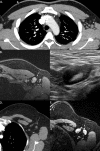Axillary Lymphadenopathy After mRNA COVID-19 Vaccination
- PMID: 33778667
- PMCID: PMC7861140
- DOI: 10.1148/ryct.2021210008
Axillary Lymphadenopathy After mRNA COVID-19 Vaccination
Conflict of interest statement
Dr. Richard Ahn owns 20 shares of Pfizer stock. Dr. Richard Ahn has no other relationship and no funding from Pfizer. Dr. Suhny Abbara reports royalty income from Elsevier/Amirsys. Dr. Cecelia Brewington reports grant funding from Cannon Medical Systems. Dr. Ann Mootz reports no conflicts of interest.
Figures

References
-
- Ecanow JS, Abe H, Newstead GM, Ecanow DB, Jeske JM. Axillary Staging of Breast Cancer: What the Radiologist Should Know. Radiographics. 2013;33(6):1589-612. doi: 10.1148/rg.336125060. PubMed PMID: 24108553. - PubMed
-
- Pfizer-BioNTech COVID-19 Vaccine; FDA Briefing Document . Vaccines and Related Biological Products Advisory Committee Meeting. December, 10 2020
LinkOut - more resources
Full Text Sources
Other Literature Sources

